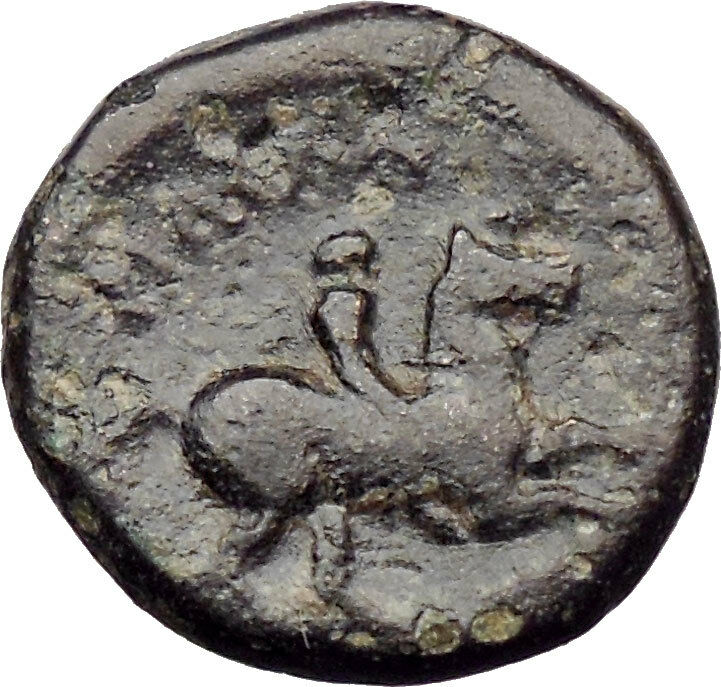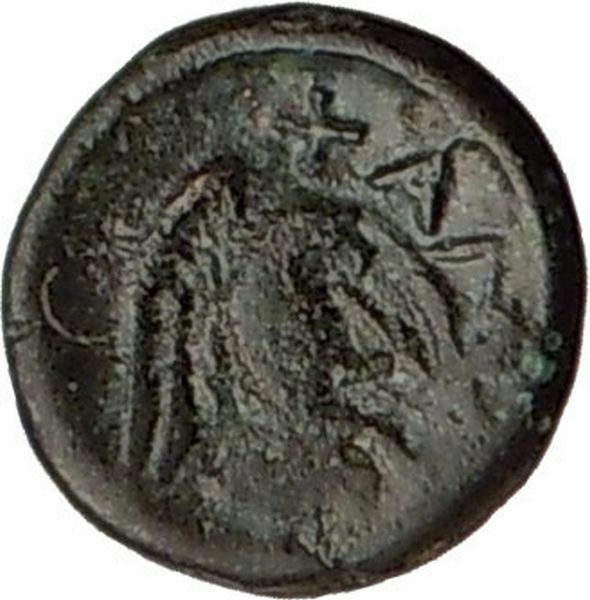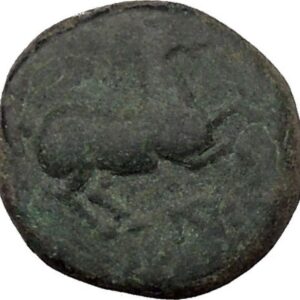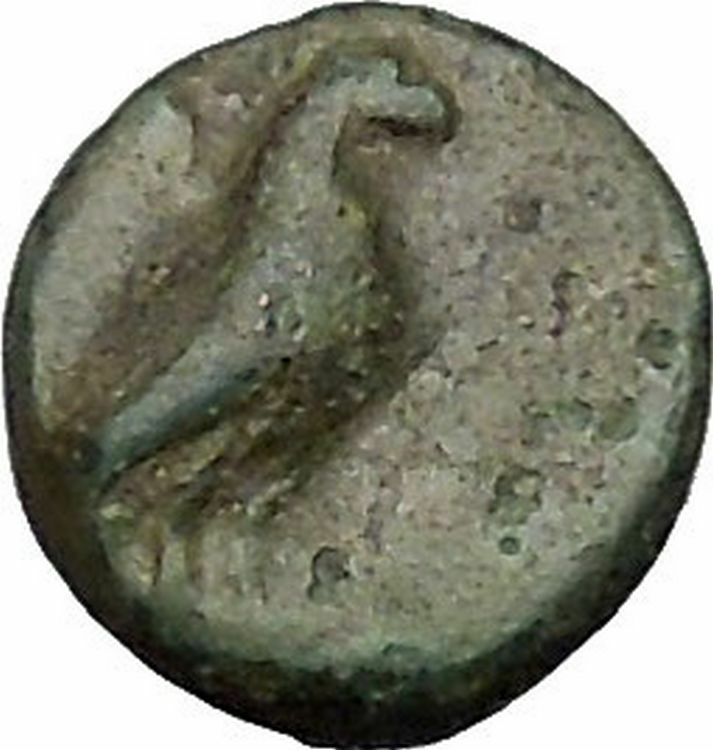|
Greek city of
Termessos Major
in
Pisidia
Bronze 19mm (5.67 grams) Struck 51 B.C.
Reference: SNG v. Aul. – ; SNG Cop. 329; SNG France 2133 ff.
Laureate head of
Zeus
right.
Forepart of
horse
galloping left; K (=year 20) above, TEP beneath.
An important city of south-western Pisidia, high up in the Tauros mountains, Termessos at one time controlled a large area of territory
extending into northern Lycia. Its position was given recognition by the Romans
in 71 B.C. from which era its earliest coins date.
You are bidding on the exact item pictured,
provided with a Certificate of Authenticity and Lifetime Guarantee of
Authenticity.
In the
ancient Greek
religion,
Zeus
was the “Father of Gods and men” (πατὴρ
ἀνδρῶν τε θεῶν τε)
who ruled the Olympians of
Mount Olympus
as a father ruled the family. He was the
god of sky
and
thunder
in
Greek mythology
.
His
Roman
counterpart is
Jupiter
and
Etruscan
counterpart is
Tinia
.![The Jupiter de Smyrne, discovered in Smyrna in 1680[1]](https://upload.wikimedia.org/wikipedia/commons/thumb/c/c8/Jupiter_Smyrna_Louvre_Ma13.jpg/200px-Jupiter_Smyrna_Louvre_Ma13.jpg)
Zeus was the child of
Cronus
and
Rhea
,
and the youngest of his siblings. In most traditions he was married to
Hera, although, at the
oracle of Dodona
,
his consort was
Dione
:
according to the Iliad
,
he is the father of
Aphrodite
by Dione. He is known for his erotic escapades. These resulted in many godly and
heroic offspring, including
Athena
,
Apollo
and Artemis
,
Hermes
,
Persephone
(by Demeter
),
Dionysus
,
Perseus
,
Heracles
,
Helen of Troy
,
Minos
,
and the Muses
(by Mnemosyne
);
by Hera, he is usually said to have fathered
Ares,
Hebe
and Hephaestus
.
As
Walter Burkert
points out in his book, Greek Religion, “Even the gods who are not his
natural children address him as Father, and all the gods rise in his presence.”
For the Greeks, he was the
King of the Gods
,
who oversaw the universe. As
Pausanias
observed, “That Zeus is king in heaven is a saying common to all men”. In
Hesiod’s Theogony
Zeus assigns the various gods their roles. In the Homeric Hymns he is
referred to as the chieftain of the gods.
His symbols are the
thunderbolt
,
eagle
,
bull
,
and oak
.
In addition to his Indo-European inheritance, the classical “cloud-gatherer”
also derives certain iconographic traits from the cultures of the
Ancient Near East
,
such as the
scepter
.
Zeus is frequently depicted by Greek artists in one of two poses: standing,
striding forward, with a thunderbolt leveled in his raised right hand, or seated
in majesty.
Pisidia was a region of ancient
Asia Minor
located north of
Lycia
, and bordering
Caria
,
Lydia
,
Phrygia
and
Pamphylia
. It corresponds roughly to the
modern-day province of
Antalya
in
Turkey
. Among Pisidia’s settlements were
Termessus
,
Selge
,
Cremna
,
Sagalassos
,
Etenna
,
Antiochia
,
Neapolis
,
Tyriacum
,
Laodiceia Katakekaumene
and
Philomelium
.

Amphiteatre of Termessos
Geography
Although close to
Mediterranean Sea
on the map, the warm climate
of the south cannot pass the height of the
Taurus Mountains
. Owing to the climate, there
is no timberland but crop plants grow in areas provided with water from the
mountains, whose annual average rainfall is c. 1000 mm on the peaks and 500 mm
on the slopes. This water feeds the plateau. The Pisidian cities, mostly founded
on the slopes, benefited from this fertility. The irrigated soil of the land is
very suitable for growing fruit and for husbandry.
History
Early history
The area of Pisidia has been inhabited since the
Paleolithic
age, with some settlements known
from historical times ranging in age from the eighth to third millennium BC. The
ancestors of the classical Pisidians were likely present in the region before
the 14th century BC, when
Hittite
records refer to a mountain site of
Salawassa, identified with the later site of Sagalassos. At that time,
Pisidia appears to have been part of the region the Hittites called
Arzawa
. The Pisidian language is poorly
known, but is assumed to be a member of the
Anatolian
branch of
Indo-European languages
.
Herodotus
mentioned the Pisidic people in the
text which they were called “Lakuna” but this was one of the names given to
Pisidic tribes, which occupied a little mountainous region north to the Antalya
Bay. Pisidians are known to be among the nations which helped the Persians in
their war against Greece.
There can be little doubt that the Pisidians and Pamphylians were the same
people, but the distinction between the two seems to have been established at an
early period. Herodotus
, who does not mention the Pisidians,
enumerates the Pamphylians among the nations of Asia Minor, while
Ephorus
mentions them both, correctly including
the one among the nations on the interior, the other among those of the coast.
Pamphylia early received colonies from
Greece
and other lands, and from this cause,
combined with the greater fertility of their territory, became more civilized
than its neighbor in the interior. Pisidia remained a wild, mountainous region,
and one of the most difficult for outside powers to rule.
As far back as the Hittite period, Pisidia was host to independent
communities not under the Hittite yoke. Known for its warlike factions, it
remained largely independent of the
Lydians
, and even the
Persians
, who conquered
Anatolia
in the 6th century BC, and divided the
area into satrapies
for greater control, were unable to
cope with constant uprisings and turmoil.
Hellenistic period
Alexander the Great
had somewhat better
fortune, conquering Sagalassos on his way to Persia, though the city of
Termessos
defied him. After Alexander died, the
region became part of territories of
Antigonus Monophthalmus
, and possibly
Lysimachus of Thrace
, after which
Seleucus I Nicator
, founder of the
Seleucid
Dynasty of
Syria
, took control of Pisidia. Under the
Selucids Greek colonies were founded at strategically important places and the
local people
Hellenised
. Even so, the
Hellenistic
kings were never in complete
control, in part because
Anatolia
was contested between the Selucids,
the
Attalids
of
Pergamon
, and the
Galatians
, invading
Celts
from
Europe
. The cities in Pisidia were among the
last in western Anatolia to fully adopt Greek culture and to coin their own
money.
Pisidia officially passed from the Selucids to the Attalids as a result of
the
Treaty of Apamea
, forced on
Antiochos III
of Syria by the
Romans
in 188 BC. After
Attalos III
, the last king of Pergamon,
bequeathed his kingdom to Rome in 133 BC as the
province of Asia
, Pisidia was given to the
Kingdom of Cappadocia
, which proved unable to govern it.
The Pisidians cast their lot with pirate-dominated
Cilicia
and Pamphylia until Roman rule was
restored in 102 BC.
In 39 BC
Marcus Antonius
entrusted Pisidia to the
Galatian
client king
Amyntas
and charged him with putting down the
bandit
Homonadesians
of the Taurus Mountains, who
threatened the roads connecting Pisidia to Pamphylia. After Amyntas was killed
in the struggle 25 BC, Rome made Pisidia part of the new province of Galatia.
The Homonadesians were finally wiped out in 3 BC.
Roman and
Byzantine period
During the Roman period Pisidia was colonized the area with veterans of its
legions
to maintain control. For the colonists,
who came from poorer parts of
Italy
, agriculture must have been the area’s
main attraction. Under
Augustus
, eight colonies were established in
Pisidia, and Antioch and Sagalassos became the most important urban centers. The
province was gradually Latinised. Latin remained the formal language of the area
until the end of the 3rd century.
Pisidia was important in the early spread of
Christianity
.
St. Paul
visited
Antioch
on each of his missionary journeys,
helping to make it a center of the new faith in Anatolia. After the
Emperor Constantine
‘s legalization of
Christianity in 311 it played an important role as a metropolitan city.
Afterwards it became the capital city of the Christian Pisidian Province,
founded in the 4th century;
Parlais
became its
titular see
. Most Pisidian cities were heavily
fortified at that time due to civil wars and foreign invasions.
The area was devastated by
earthquake
in 518, a plague around 541-543, and
another earthquake and Arab raids in the middle of the 7th century. After the
Muslim
conquest of
Syria
disrupted trade routes, the area declined
in importance. In the 8th century the raids increased. In the 11th century the
Seljuk Turks
captured the area and founded the
Seljuk Sultanate
in Central Anatolia. Pisidia
constantly changed hands between the
Eastern Roman Empire
and the Turks until 1176,
when the Great Sultan
Kılıçarslan
defeated
Manuel Commenos
in the
Myriokephalon
(thousand heads), which ended
Roman rule and cemented Turkish rule of the area.
|





![The Jupiter de Smyrne, discovered in Smyrna in 1680[1]](https://upload.wikimedia.org/wikipedia/commons/thumb/c/c8/Jupiter_Smyrna_Louvre_Ma13.jpg/200px-Jupiter_Smyrna_Louvre_Ma13.jpg)




